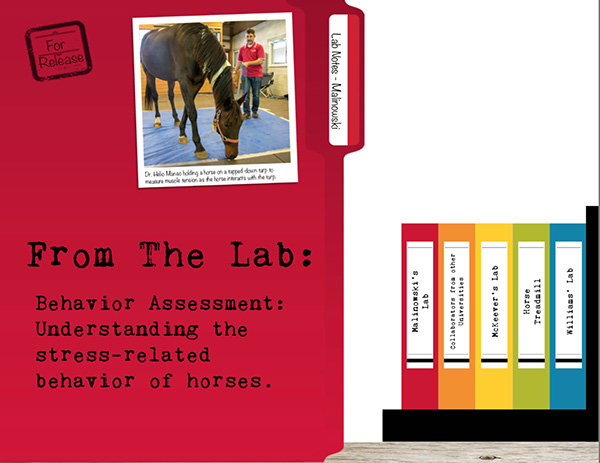From the Lab: Behavior Assessment- Understanding Stress-Related Behavior of Horses

Rutgers Equine Science Center
Lab Notes- Malinowksi
Top 5 Take-Aways
#1- The specific behaviors of vocalization, kick, head tossing, head shake, pawing, rear, head movements, and total behaviors were correlated to horses in isolation; meanwhile blowing/snorting and sniffing behaviors were correlated to horses exposed to a novel object.
#2- Qualitative behavior assessment allows observers to use their own terms and interpretation of behavior to describe what they see: our observers agreed on terms that ranged from “Calm/Patient” and “Agitated/ Stressed” to “Curious/Investigative” and “Inactive/Content.”
#3- The horses in isolation were described by observers primarily as “Agitated/ Stressed,” while horses exposed to an unfamiliar object were described as “Curious/ Investigative.”
#4- These findings support the combination of assessment methods for future use in welfare, monitoring routine care, or establishing criteria for selecting horses (either for personal enjoyment, good fit for a lesson horse or new to the herd, or for equine- assisted activities and therapy environments).
#5- Quantitative behavior assessment methods are good at providing a concrete but incomplete picture of a horse’s behavior by evaluating how many times a horse performs a specific behavior: in our study, horses in isolation presented more total stress-related behaviors compared to control.
This study tested the combination of two behavior assessment methods to get a deeper understanding of stress-related behavior in horses. Quantitative assessments provide information on the number of times a horse may perform a behavior, while qualitative assessments allow an observer to describe in words the behaviors a horse is exhibiting. We placed horses in each of the four treatments: Standing control in a stall, exposure to an unfamiliar object, electric clippers near the head and neck, and isolation from companion horses in the barn.
For the quantitative assessment, trained observers used an ethogram, a tool that lists specific stress-related behaviors, to count the frequency of each behavior during the four treatments. The results revealed that horses in the isolation treatment showed significantly more stress-related behaviors than in the control treatment. For the qualitative assessment, observers wrote down in unique terms to describe each horse in all treatments. Observers had a high level of agreement and described horses as “Calm/Patient,” “Agitated/Stressed,” “Curious/Investigative,” and “Inactive/Content.”
When we combined the data from the two assessments, we found that horses in the isolation treatments were usually described as “Agitated/Stressed,” while horses exposed to an unfamiliar object were “Curious/Investigative,” and horses displayed behaviors that corresponded to both situations. Since the qualitative assessment allowed observers to use their own terms to describe horses, each individual was able to consider the context of the treatment and the horse’s total body language.
In contrast, the qualitative assessment only allows observers to count the number of a predetermined behavior. This story supported the hypotheses that combining quantitative and qualitative behavior assessment would result in agreement between observers and provide a more complete understanding of horse behavior.
Reprinted courtesy of the Rutgers Equine Science Center’s Equine Science Quarterly. Visit esc.rutgers.edu, and subscribe to the Rutgers University Equine Science Quarterly for the latest in “Better Horse Care through Research and Education.”










